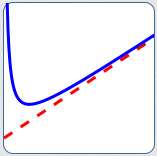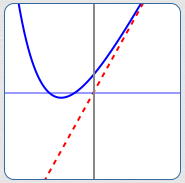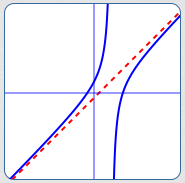how to find a slant asymptote
Functions can 'get big' in different ways.
When they 'get big' by looking more and more like a 'slanted' line (i.e., not horizontal and not vertical),
then the function is said to have a slant asymptote.
Slant asymptotes are also called oblique asymptotes.
| As discussed in Introduction to Asymptotes, an asymptote is a curve (usually a line) Here's how this general definition is 'specialized' to get a slant asymptote: that another curve gets arbitrarily close to as $\,x\,$ approaches $\,+\infty\,$ or $\,-\infty\,$. What's the key to a slant asymptote situation? as inputs get arbitrarily large (big and positive, or big and negative). This section gives a precise discussion of slant asymptotes, |  The red line is a slant asymptote As $\,x\rightarrow\infty\,$, |
Conditions under which $\,y = mx + b\,$ ($\,m\ne 0\,$)
is a Slant Asymptote for a Function $\,f\,$
Let $\,f\,$ be a nonlinear function.
That is, $\,f(x)\,$ is not of the form $\,f(x) = cx + d\,$ for any real numbers $\,c\,$ and $\,d\,$.
Let $\,m \ne 0\,$.
The line $\,y = mx + b\,$ is a slant asymptote for $\,f\,$
if and only if at least one of the following conditions holds:
- as $\,x\rightarrow\infty\,$, $\,f(x) - (mx + b) \rightarrow 0\,$
- as $\,x\rightarrow -\infty\,$, $\,f(x) - (mx + b) \rightarrow 0\,$
That is, the vertical distance between the line $\,y = mx + b\,$ and the graph of $\,f\,$ approaches zero as $\,x\rightarrow\infty\,$ or $\,x\rightarrow -\infty\,$ (or both).
- A function can have at most two slant asymptotes.
It can approach one line as $\,x\rightarrow\infty\,$, and a different line as $\,x\rightarrow -\infty\,$. - A function can have a slant asymptote and a horizontal asymptote.
For example, it might approach a horizontal line as $\,x\rightarrow\infty\,$, and a slanted line as $\,x\rightarrow -\infty\,$.
Example:
A Non-Rational Function with a Slant Asymptote
| Let $\,f(x) = 3x + \text{e}^{-x}\,$ (the blue curve at right). |  |
Example:
A Rational Function with a Slant Asymptote;
degree of numerator is exactly one greater than degree of denominator
Let $\displaystyle\,R(x) = \frac{x^2 - 4x - 5}{x - 3}\,$.
When $\,x\,$ is big, the outputs from $\,R(x)\,$ looks like $\,\frac{\text{big}}{\text{big}}\,$, which is not very useful.
As usual, we will rename the function to better understand what happens when $\,x\,$ is big:
The key is to do a long division:
| $x$ | $-$ | $1$ | |||
| $x-3$ | $x^2$ | $-$ | $4x$ | $-$ | $5$ |
| $-(x^2$ | $-$ | $3x$ | $)$ | ||
| $-x$ | $-$ | $5$ | |||
| $-($ | $-x$ | $+$ | $3)$ | ||
| $-8$ | |||||
Thus, $$ \cssId{s54}{R(x)} \cssId{s55}{= \frac{x^2 - 4x - 5}{x - 3}} \ \ \cssId{s56}{=\ \ x - 1 \ \ \ + \overbrace{\left(\frac{-8}{x-3}\right)}^{\text{this part tends to zero}}} $$
Note that as $\,x\rightarrow\pm\infty\,$, $\displaystyle\,\frac{-8}{x-3}\rightarrow 0\,$.
Therefore, as inputs get big, the function is looking more and more like the line $\,y = x - 1\,$.
Thus, $\,y = x - 1\,$ is a slant asymptote for the function $\,R\,$.
| The graph of the function $\,\color{blue}{R}\,$ (in blue), together with its slant asymptote $\,\color{red}{y = x - 1}\,$ (in red), is shown at right. When we were doing the long division of $\,x^2 - 4x - 5\,$ by $\,x - 3\,$ up above, |  |
In summary, we have:
Conditions under which
a Rational Function has a Slant Asymptote
Let $\,N(x)\,$ and $\,D(x)\,$ be polynomials, so that $\displaystyle\,R(x) = \frac{N(x)}{D(x)}\,$ is a rational function.
The function $\,R\,$ has a slant asymptote when the following conditions are met:
- $\deg{N(x)} = \deg{D(x)} + 1$
(the degree of the numerator is exactly one more than the degree of the denominator) - $\deg{N(x)} \ge 2$
(the numerator is at least quadratic) - when dividing $\,D(x)\,$ into $\,N(x)\,$, the remainder is not zero
- Why do we require that $\deg{N(x)}\ge 2\,$?
Notice that $\displaystyle \,y = \frac{x-1}{3}\,$ is a rational function, since both numerator and denominator are polynomials.
The degree of the numerator is $\,1\,$.
The degree of the denominator is $\,0\,$.
Thus, the degree of the numerator is exactly one more than the degree of the denominator.
However, this is just the linear function $\,y = \frac 13x - \frac 13\,$, which does not have a slant asymptote. - Why do we require the remainder to be nonzero?
Notice that $\displaystyle \,y = \frac{x^2-1}{x-1}\,$ is a rational function, and the degree of the numerator is exactly one more than the degree of the denominator.However, in this case $\,x - 1\,$ goes into $\,x^2 - 1\,$ evenly (the remainder is zero): $$ \cssId{s87}{y = \frac{x^2-1}{x-1}} \cssId{s88}{= \frac{(x-1)(x+1)}{x-1}} \cssId{s89}{= x + 1\,,} \ \ \cssId{s90}{\text{for $\,x\ne 1\,$}} $$ This function graphs as a line that is punctured at $\,x = 1\,$. It does not have a slant asymptote.
how to find a slant asymptote
Source: https://www.onemathematicalcat.org/Math/Precalculus_obj/slant_asy.htm
Posted by: torresancom1966.blogspot.com

0 Response to "how to find a slant asymptote"
Post a Comment